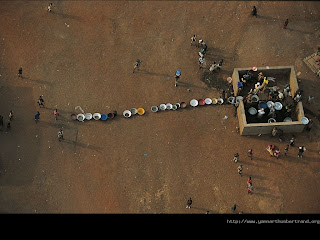Gregory Colbert's first exhibition, Timewaves, opened in 1992 at the Museum of Elysée in Switzerland to wide critical acclaim. For the next ten years, Colbert did not publicly exhibit his art or show any films. Instead, he traveled to such places as India, Burma, Sri Lanka, Egypt, Dominica, Ethiopia, Kenya, Tonga, Namibia, and Antarctica to film and photograph interactions between human beings and animals. Since 1992, he has launched more than sixty such expeditions, and has collaborated with over 130 species. Elephants, whales, manatees, sacred ibis, Antigone cranes, royal eagles, Gyr falcons, rhinoceros hornbills, cheetahs, leopards,African wild dogs, caracals, baboons, eland, meerkats, gibbons, orangutans, and saltwater crocodiles are among the animals he has filmed and photographed. Human subjects include Burmese monks, trance dancers, San people, and other indigenous tribes from around the world.
In 2002, Colbert presented his work, Ashes and Snow, in Venice, Italy. An April 9, 2002 review in The Globe and Mail stated, “Colbert unveiledAshes and Snow, an exhibition of images and photographs unprecedented in both scope and scale. Covering 12,600 square meters, it is billed as one of the largest one-man shows in the history of Europe.”
In spring 2005, the show opened in New York City in the Nomadic Museum, a temporary structure built to house the exhibition. Ashes and Snow and the Nomadic Museum then traveled to Santa Monica in 2006, Tokyo in 2007, and Mexico City in 2008. To date, Ashes and Snow has attracted over 10 million visitors, making it the most attended exhibition by a living artist in history.
Ashes and Snow has been a critical and popular success. Photo magazine declared, “A new master is born.” Ashes and Snow has been described as "extraordinary" by the Economist, and "distinctive . . . monumental in every sense" by the Wall Street Journal. Stern magazine declared that the photographs are "fascinating," and Vanity Fair described Gregory Colbert as "Best of the Best." An article in 2002 in the New York Times by Alan Riding stated “The power of the images comes less from their formal beauty than from the way they envelop the viewer in their mood. . . .They are simply windows to a world in which silence and patience govern time.”
Colbert began his career in Paris in 1983 making documentary films on social issues. His documentary, On the Brink-An AIDS chronicle, was filmed in nine countries, and was nominated for an ACE award in 1985 in the category of best documentary. Other film projects include Last Words and Finding a Way Home. Film-making led to fine arts photography.
The Nomadic Museum, the traveling home of Ashes and Snow, is charted to travel theglobe with no final destination.




































